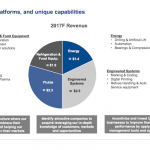On Thursday, instead of rallying, the S&P 500 fell 0.86% and the Nasdaq fell 1.44%. The S&P financials sector was up 0.65% and the technology sector was down 1.83%. The selloff was blamed on investors rebalancing their portfolios since it is the penultimate day of the quarter. In a normal market, this wouldn’t even be considered a selloff, but in this market, any time the S&P 500 moves more than 0.5% it’s a big deal.
The biggest economic report on Thursday was the Q1 GDP revision. It was initially published at 0.7%. After two revisions, the final estimate for Q1 GDP is 1.4%. The report was revised higher due to upward revisions to personal consumption expenditures and exports. As you can see in the chart below, annualized personal consumption was up 1.1% which is greater than the 0.6% growth reported in the first revision to GDP. The downward revision to fixed investment pulled the final report slightly lower.

This revision is consistent with the point I made about GDP reports after this one came out. I said advanced estimates are only a guess. This makes forecasts for what the advanced GDP report will be a guess on a guess about where the economy is. Every report needs to be taken with a grain of salt. When the final report comes out investors have long forgotten about that quarter. Investors are focused on the second half of 2017, making the report seem useless. It’s not useless. This report is in tune with the theme that Q2 won’t be a bounce back quarter. Q2 won’t be as great as initially thought and Q1 was better than what was first reported. Q2 GDP growth may only be marginally better than Q1.
The chart below shows Citi’s estimate for when the debt ceiling will be breached. As you can see, it will begin to become an issue in October if nothing gets done. I have been expecting this to become an issue in September. This extra month is great news as it gives Congress more time to raise it. The struggle will be to get the healthcare legislation passed before then, so there’s momentum to get a deal done to raise the ceiling. The two forces coming to a head are the ideological differences among Republicans in the Senate and the motivation to not want to look bad as its likely that problems with the debt ceiling will be blamed on Republicans. There is pressure to compromise to get a deal done, but if it’s a bad deal, election risks exist.














Leave A Comment